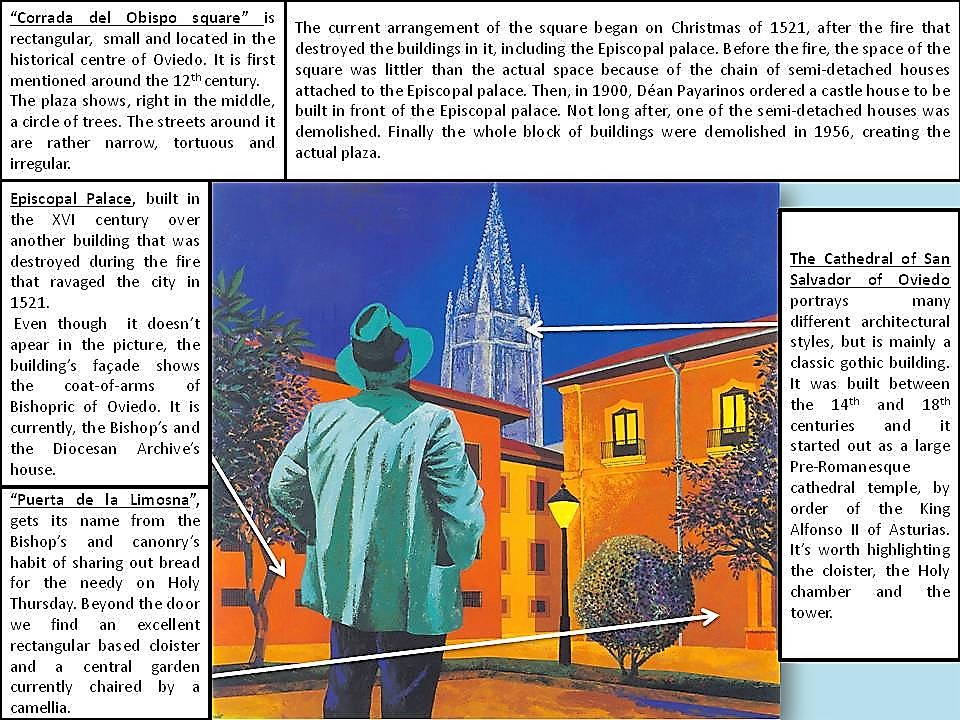OVIEDO (Eduardo Úrculo, 20th century)
The work of art I have chosen was made by Eduardo Úrculo and is called “Corrada Del Obispo”. This Basque painter and sculptor was the driving force of pop art in Spain. Even though he experienced with multiple painting styles (social expressionism, neo-cubism…) throughout his artistic career his favorite artistic trend was pop art, as it allowed him to express himself in a bolder and more intimate way. This painting is one of his many examples of pop art pictures. The image shows the author himself gazing at Oviedo Cathedral from the “Corrada del Obispo Square” at night with a very precise drawing, strong and flat colors and an almost photographic technique. It is curious to highlight that, even though, the man and the tower are the main elements that initially catch our attention, the rest of the painting uses more flashy colors that are shown in the background.
The city of Oviedo is located at the foot of a complex of hills, that are part of the foothills of the Cantabrian Mountains, and displays some unevenness from one quarter to another. Its climate is mostly warm and features a lot of rain. Oviedo is not a coastal city but an inland city so the temperatures fluctuate more than in the coastal areas. The city is organized in districts that make its management easier. Oviedo has five urban districts and two rural ones. Our picture takes place in the first urban district.
The image portrays the historical centre of Oviedo, which is emplaced over a hill, at the foot of the “Sierra del Naranco”, for defensive reasons. It is located in a strategic position in the crossing of two axes of communications: east-west and north-south. In addition, the historic quarter of Oviedo had a circular perimeter (hill) and it was surrounded by a city wall for defensive, economic and health reasons. Furthermore, it marked the start of the suburbs towards the exterior convents of the city.
Initially, the town planning was irregular, meaning that the streets were narrow, tortuous and the squares lacked of definite forms. This irregularity was mitigated later on due to multiple circumstances. Amongst them: the fire of 1521 (that allowed the regularization of the streets in an octagonal sense and the opening of squares), the disentailment (that allowed the correction of the street’s outline, the opening of new roads and the creation of plazas), and the demolition and interior remodeling of the 20th century (the Cathedral‘s square).
Regarding the architecture, initially there were low rise buildings. However, the houses have recently experienced many renovations, plus a growing edification of high rise buildings. This is due to the destruction caused by the revolution of 1934, the Civil war and the renovation plans of the 60’s. It’s worth highlighting that the bourgeoisie left the old town at the end of the 19th century to move to the new areas and rented the houses to working-class families that couldn’t afford improving the buildings. As a consequence, most houses experienced deterioration. Currently, the old town also suffers from an environmental deterioration (traffic, noise, pollution, house’s remodeling…), the influence of the tertiary sector (businesses, offices…) and ageing population.
Regarding the urban elements, it is worth mentioning that the square is delimited by three key buildings. At the top of the picture, in the background behind some buildings, we find the Cathedral of San Salvador of Oviedo that displays an array of architectural styles having some pre-romanesque, baroque, romanesque, gothic and renaissance features. However, it is mainly a classic, flamboyant and conservative Gothic building, which was built between the 14th and 18th centuries. The cathedral has three naves with side chapels, a transept and a tripartite apse. It was built on a temple from the 8th century and it began as a large Pre-Romanesque cathedral temple, by order of the King Alfonso II of Asturias. It’s worth highlighting the cloister, the Holy chamber and the tower. In the middle of the picture, behind the author on the left side, we find the Episcopal Palace and right next to it, on the right, there’s the “Puerta de la Limosna”. It is curious to note that a historical event took place here in the square: after Napoleon’s invasion, on the 25th of May of 1808, Asturias self-proclaimed sovereign and declared the war on France. This declaration was read from the balcony of the “Puerta de la Limosna”.
Finally, Oviedo is home to numerous museums, churches, pieces of art… It is full of history. In fact it has been declared a World Cultural Heritage. Oviedo’s economy is strongly dependent on the service sector. Moreover, trade has turned into its main economic sector, as it’s a very well connected city. Oviedo is a city, economically speaking, that thrives on the service sector, with many office buildings in the city centre, and on tourism.
Laura Espada López

